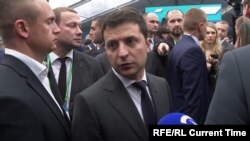After more than five years of war, Ukraine on October 29 began its promised troop withdrawal from the Donbas conflict zone, with President Volodymyr Zelenskiy traveling to the site to supervise the operation. In comments to Current Time, the Ukrainian leader emphasized that the controversial pullout, the cause of recent protests in Kyiv and other Ukrainian cities, was proceeding “smoothly.”
“Everything is calm. We are in control of everything. Everything will be calm,” said Zelenskiy during a visit to the frontline town of Zolote, which has one section under separatist control.
The Organization for Security and Cooperation in Europe (OSCE), which has observers stationed in Donbas, confirmed on October 29 that both Ukrainian and separatist forces were seen “exiting the disengagement area, together with their weapons.”
As part of Ukraine and Russia’s October 1 agreement to the so-called Steinmeier Formula, a guideline for kickstarting the peace-talk process, Ukrainian and pro-Moscow separatist forces must withdraw from two locations in the eastern region of Luhansk -- Stanytsya Luhanska and Zolote -- and Petrivske from the neighboring region of Donetsk. The OSCE will monitor the withdrawal.
Ukraine halted an earlier withdrawal this month after Zolote came under separatist gunfire. But Ukrainian armed forces now confirm that no gunfire has occurred in the area for more than a week.
Speaking from Mariupol, a Sea of Azov port city several hours to the south of Zolote, Ukrainian Foreign Minister Vadym Prystaiko stated that the withdrawal from Petrivske was also underway.
“We are withdrawing now from Petrivske as I speak,” Prystaiko commented to Current Time. “And these are all the conditions [for talks with Germany, France, and Russia] to which we, as the president’s foreign policy advisors, agreed …”
Ukraine already has “fully” withdrawn its forces from Stanytsya Luhanska, about 100 kilometers to the east of Zolote, and is building a bridge between Ukrainian and separatist-controlled territory at the location, he added.
“I do not see any other reason for the Russians to not find the time to meet the four leaders,” Prystaiko continued, in reference to the peace talks.
Since 2014, the war in Donbas has displaced roughly 1.4 million people and killed some 13,000 – the most devastating conflict on the European continent since the breakup of Yugoslavia in the 1990s.







